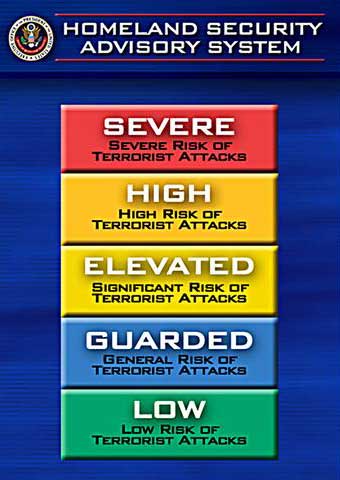Risk Definitions

- Low Condition (Green). This condition is declared when there is a low risk of terrorist attacks. Federal departments and agencies should consider the following general measures in addition to the agency-specific Protective Measures they develop and implement:
- Refining and exercising as appropriate preplanned Protective Measures;
- Ensuring personnel receive proper training on the Homeland Security Advisory System and specific preplanned department or agency Protective Measures; and
- Institutionalizing a process to assure that all facilities and regulated sectors are regularly assessed for vulnerabilities to terrorist attacks, and all reasonable measures are taken to mitigate these vulnerabilities.
- Guarded Condition (Blue). This condition is declared when there is a general risk of terrorist attacks. In addition to the Protective Measures taken in the previous Threat Condition, Federal departments and agencies should consider the following general measures in addition to the agency-specific Protective Measures that they will develop and implement:
- Checking communications with designated emergency response or command locations;
- Reviewing and updating emergency response procedures; and
- Providing the public with any information that would strengthen its ability to act appropriately.
- Elevated Condition (Yellow). An Elevated Condition is declared when there is a significant risk of terrorist attacks. In addition to the Protective Measures taken in the previous Threat Conditions, Federal departments and agencies should consider the following general measures in addition to the Protective Measures that they will develop and implement:
- Increasing surveillance of critical locations;
- Coordinating emergency plans as appropriate with nearby jurisdictions;
- Assessing whether the precise characteristics of the threat require the further refinement of preplanned Protective Measures; and
- Implementing, as appropriate, contingency and emergency response plans.
- High Condition (Orange). A High Condition is declared when there is a high risk of terrorist attacks. In addition to the Protective Measures taken in the previous Threat Conditions, Federal departments and agencies should consider the following general measures in addition to the agency-specific Protective Measures that they will develop and implement:
- Coordinating necessary security efforts with Federal, State, and local law enforcement agencies or any National Guard or other appropriate armed forces organizations;
- Taking additional precautions at public events and possibly considering alternative venues or even cancellation;
- Preparing to execute contingency procedures, such as moving to an alternate site or dispersing their workforce; and
- Restricting threatened facility access to essential personnel only.
-
Severe Condition (Red). A Severe Condition reflects a severe risk of terrorist attacks. Under most circumstances, the Protective Measures for a Severe Condition are not intended to be sustained for substantial periods of time. In addition to the Protective Measures in the previous Threat Conditions, Federal departments and agencies also should consider the following general measures in addition to the agency-specific Protective Measures that they will develop and implement:
- Increasing or redirecting personnel to address critical emergency needs;
- Assigning emergency response personnel and pre-positioning and mobilizing specially trained teams or resources;
- Monitoring, redirecting, or constraining transportation systems; and
- Closing public and government facilities.
|
